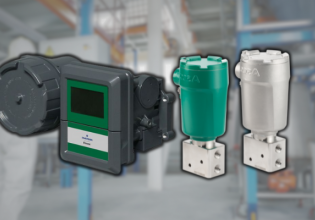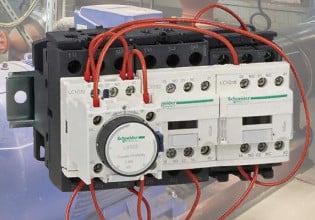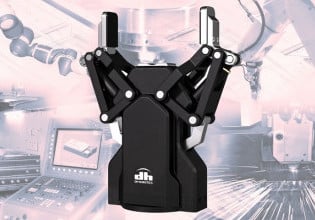Calculating the Speed of a Conveyor System
Different conveyance systems have different ways to calculate speed. Let’s dive into these systems, their speed, and some determining factors.
The speed of a conveyor system is heavily dependent on the application of the conveyor. Some conveyors move the average speed of a person walking, while other applications require a much faster speed; for example, a high-speed bottling line.

Figure 1. A fast bucket conveyor. Image used courtesy of Bosch Rexroth [PDF]
Typically, two types of belt or chain conveyors are used in production: continuous motion production and shuttle conveyors.
Both styles are subjected to machine speed to determine the speed of the conveyor along with other factors. There are also track conveyor systems that can be used as a continuous conveyor system or a shuttle conveyor system. A track conveyor system would have the same challenges as the typical belt or chain conveyors.
Before diving into how to calculate the speed of a conveyor, let’s first look at the types of conveyors. This will give us a broad understanding of why we’ll need to know the system’s speed.
An Overview of Conveyance Systems
A few conveyor types that we’ll review include continuous motion, shuttle, and servo-driven.
Continuous Motion Conveyor
This style of conveyor is typically found on bottling lines or food production. One can find continuous motion production in any factory where the product manufacturing cannot stop without repercussions. The product is transferred to and from process machines without stopping. This conveyor style is typically very fast and limited only by the speed of the machines that do the processing.

Figure 2. A bottling conveyor. Image used courtesy of Tri-Mach
Shuttle Conveyor
A shuttle conveyor typically consists of a low friction continuously running belt or chain. A shuttle, where parts or the product is clamped, travels on the belt or chain and slips when the shuttle stops. The shuttles move from machine process to machine process, stopping at each machine (station or cell) to be worked on. The speed of this conveyor style is typically determined by the machine’s overall takt time or the fastest process on the assembly line.
Figure 3. Video used courtesy of ATS Automation
Servo-driven Conveyor
A servo-driven conveyor will likely start and stop as needed and move to a precise position, similar to an indexing table. With a servo motor driving the conveyor, the speed is only limited by the product’s weight and the product’s stability. If moving a liquid, the acceleration and deceleration values need to be tuned so that the product does not become disturbed.
Now that we understand why speed is important for these conveyor types, let’s dive into calculating the speed.
Calculating Conveyor Speed
The conveyor belt speed is calculated as the circumference of the drive roller times the rotations per minute (RPM) of the motor. If there is any gear reduction, don’t forget to apply the ratio to the RPM before multiplying the circumference.
A conventional track conveyor would use the same formula as above if using an AC motor to drive the track. If using a servo-driven belt conveyor, the speed can be calculated within the servo motor’s control system. Any servo conveyor will rely heavily on the takt time of the system and the type of material being transported to calculate the speed.
Determining Factors of Conveyor Speed
When determining the required conveyor speed, there are some factors we must consider. This is a general idea and isn’t intended to be a comprehensive list. Other factors could include fragile products and packaging needs.

Figure 4. A low-friction conveyor. Image used courtesy of Dorner
Motor speed: A typical AC motor RPM is around 1750–3500, too fast for a conveyor. A gearbox or gear reduction device is required to reduce the total motor RPM. If the system cycle time and size of the drive roller are known, then we can easily calculate the RPM required.
Product weight: As the product’s weight on the conveyor increases, the force required to move the product also increases. Product weight can also affect belt acceleration and deceleration. A low friction belt conveyor, which relies on shuttles or products to slip on the belt when stopped at a station, will have a maximum payload. This style may have to be switched out to a chain conveyor or heavy-duty roller conveyor. A servo track conveyor will be susceptible to payload due to the shuttles being held on with magnetic force.
Machine cycle time: The cycle time of a system is important to both the equipment manufacturer and the customer purchasing the machine. This means the conveyor must move the product throughout the system at the designed cycle time rate.
Controls: A typical AC motor-driven belt conveyor will need nothing more than a digital output and a motor starter contactor. If stopping the motor frequently, a variable frequency drive (VFD) would be a good option to reduce energy use. Servo-driven conveyors, whether tracks or belts, will require a servo drive and controller, typically a programmable logic controller (PLC), to command the servo motor to different positions. These controls can be expensive and may be overcomplicated for the application.
As a controls technician, it is important to know the speed of the conveyor to ensure each station or cell within the system can access its necessary parts. It is important not to starve a station, as that could reduce your overall system’s takt time. The speed of any conveyor can be calculated during the design phase, and it is during this phase where improvements to the system can be easily made if required.
Interested in more conveyance system content?
- Introduction to Conveyor Belt Systems
- What Makes a Smart Conveyor System “Smart”?
- Conveyor Belt Maintenance Strategies
- VSD and VFD Motor Drive Features






